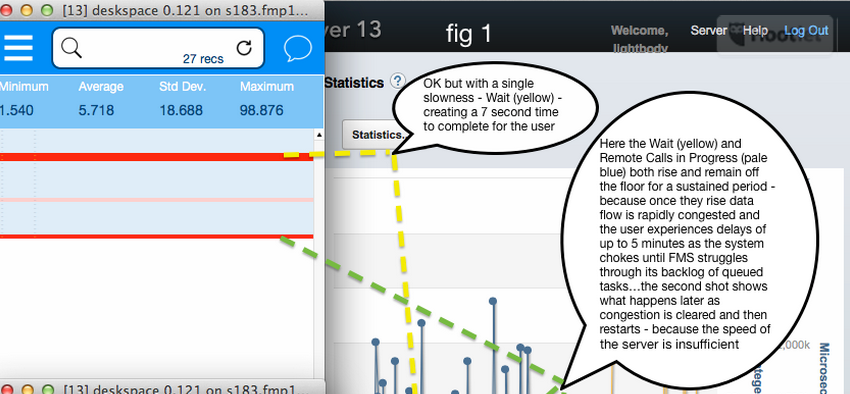Stop FileMaker Server from overloading
Nick Lightbody, of Deskspace Systems Ltd, has his first guest host post at FileMakerHacks. It’s about dealing with overloaded FileMaker 13 servers, and he’s done a pretty thorough job of describing the issue, addressing the problem, and giving the solutions.
The true load factor on FileMaker Server itself – ignoring for these purposes the load caused by slow networks and slow data storage i/o – is not the number of FileMaker clients but the number and frequency of remote calls, one of the 11 statistics observable in the FileMaker Server Admin Console under Statistics. For our investigation we need to turn on the following statistics — but remember that these numbers are each a sample of a single moment in Server’s operation (at the time the sample is taken), so turn the sample frequency in Admin Console up to every 3 seconds to get a better idea of what is happening, then turn it down again when not required since measuring anything also affects what you are measuring — in this case by creating load, so a higher frequency will slow down normal operation.
(1) Remote calls/sec – this represents the server load – each call being a significant set of instructions
(2) Remote calls in Progress – at any single moment – when the sample is taken – often zero
(3) Wait time (ms)/call – this shows the effect of load – the output – delivering the user experience …Choking is simply that: the rate of new calls on server exceeding its ability to deal — hence an ever increasing queue builds up which takes time to be dealt with by the Server and then, eventually, cleared.
This choking characteristic is why folk may be misinforming themselves when they look at the stats and think their server has much more spare capacity available than is in fact the case. The moment Remote Calls in Progress exceeds the number of cores available in the CPU, the risk of a suddenly escalating choke arises. The choke develops very rapidly — each delay multiplying further delays behind it — so the apparent surplus capacity disappears in an instance.
Lightbody offers a series of steps to help prevent overload, the most intriguing of which is a ‘token’ system he devised to regulate traffic requests to the server. That system resulted in a better balance of productivity vs user experience”
We assess deployments using a Productivity Index for the systems capacity (larger is better) and a User Experience Index (smaller is better) to predict the goodness — or otherwise — of the user experience. When we turned token flow-control off you can see (in the red boxes) that the Productivity declined from 51 to 45 and the User Experience declined from 25 to 410
I look forward to further articles on this subject. Thanks for the research, Nick!
What is happening when FileMaker Server becomes overloaded (and how to avoid it) | FileMakerHacks.

